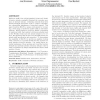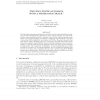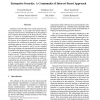482 search results - page 42 / 97 » A taxonomy of computer worms |
IMC
2004
ACM
14 years 2 months ago
2004
ACM
Malicious traffic from self-propagating worms and denialof-service attacks constantly threatens the everyday operation of Internet systems. Defending networks from these threats d...
CIA
2008
Springer
13 years 10 months ago
2008
Springer
Network devices can filter traffic in order to protect end-user computers against network worms and other threats. Since these devices have very limited memories and cannot deploy ...
JALC
2007
13 years 8 months ago
2007
The basic finite automata model has been extended over the years with different acceptance modes (nondeterminism, alternation), new or improved devices (two-way heads, pebbles, ...
VMV
2001
13 years 10 months ago
2001
Computational steering requires the coupling of simulation and visualization elements, but if the latter is targetted at general requirements, little or no information about the c...
NDSS
2006
IEEE
14 years 2 months ago
2006
IEEE
Enterprise networks today carry a range of mission critical communications. A successful worm attack within an enterprise network can be substantially more devastating to most com...



